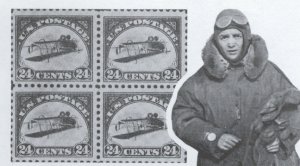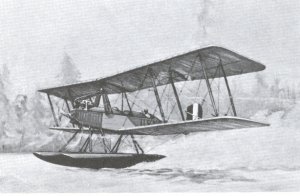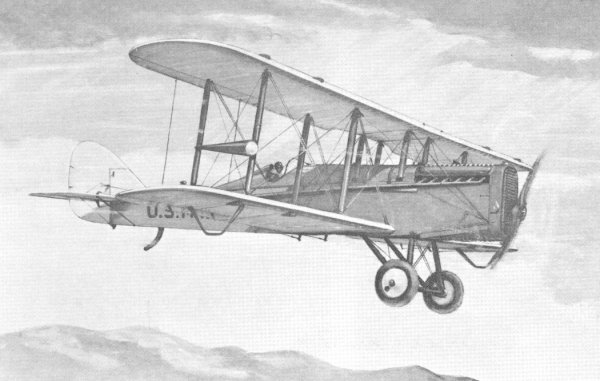
|
|
|
A BRIEF HISTORY (May 15, 1918 -- August 31, 1927) As written and edited by Edward A. Keogh -- 1927 From "Saga of the U.S. Air Mail Service" |
THE FIRST aerial mail transportation may be traced back to 1870, when in that year letters were carried out of beleaguered Paris by free balloons, cast adrift in the winds. The first of such flights was made on September 23, 1870, and carried 500 pounds of mail. This service, of course, was not satisfactory, as the balloons could not be controlled and were just as liable as not to land in enemy territory. Some of them were carried by the winds many miles from Paris before they came down, and some of them were never heard of after leaving Paris.
In the year 1911 demonstrations of airplane mail service were made in India, England and the United States. The first air mail service in the United States, however, was conducted at the aviation meeting at Nassau Boulevard, Long Island, N. Y., during the week of September 23 to 30, 1911. Earle L. Ovington, with his "Queen" monoplane, was duly appointed an air mail carrier and covered a set route between the temporary post office established at the flying field and the post office at Mineola, N. Y., dropping the pouches at the latter point for the postmaster to pick up. This service, performed without expense to the Department, was flown at regular intervals during the period, a total of 32,415 post cards, 3,993 letters and 1,062 circulars being carried. It was quite satisfactory on the whole, and very promising. A few other similar experiments were made during the remainder of the year 1911, and the Post Office Department recognizing the possibility of developing the airplane into a practicable means of aerial transportation, made recommendation to Congress early in 1912 for an appropriation of $50,000 with which to start an experimental service, but Congress refused to grant the appropriation. Notwithstanding, the keen interest of the Post Office Department in aerial transportation was kept up and during the fiscal year 1912 a total of 31 orders, covering 16 different states, were issued permitting mail to be carried on short exhibition and experimental flights between certain points. Such service was merely temporary, of course, but performed in each instance by a sworn carrier, and without expense to the Department. These experimental flights were continued, however, request being made on Congress for an air mail appropriation from year to year. During the fiscal year 1916 funds were made available for the payment of aeroplane service, out of the appropriation for Steamboat or other Power Boat Service, and in that year advertisements were issued inviting bids for service on one route in Massachusetts and on several in Alaska. No bids were received under the advertisements, due to the fact that possible bidders were unable to obtain suitably constructed planes for the proposed service. Nevertheless, negotiations with airplane manufacturers and other interested aviation activities were pushed forward, looking to the earliest possible establishment of a carefully conducted experimental air mail service. The development of the airplane in the World War, and the important part it was then playing as a fighting factor in that great struggle, also served to further strengthen the belief of postal officials that it certainly could be developed into a means of fast commercial and mail transportation as well. A final step looking toward this end was taken when Congress appropriated $100,000 for the fiscal year ending June 30, 1918, to be used in the establishment of an experimental air mail route.
Careful preliminary study and consideration had been given this new undertaking and on May 15, 1918, the first air mail route in the United States was established between New York, N. Y., and Washington, D. C., with a stop at Philadelphia, Pa., for the exchange of mails or plane. The distance of the route was approximately 218 miles and the frequency of service was one round trip daily, except Sunday. This service was inaugurated with the cooperation of the War Department, which furnished the planes and pilots and conducted the flying and maintenance operations, the Post Office Department handling the mail and matters relating thereto. The cooperation of the War Department, which was of great value, was maintained until August 12, 1918, when the Post Office Department took over the entire operation of the route, furnishing its own equipment and personnel.
Flights on regular schedule, in all kinds of weather, presented new and unsolved problems, but gradually difficulties were overcome and a very reliable percentage of performance was attained over the route. In fact, the operation of this experimental route was so successful that the Department immediately began to lay plans for the extension of the service, and with a view toward the possible establishment of a transcontinental route from New York City to San Francisco. The first leg of this important route was established on July 1 of the same year. These two latter routes were utilized to advance delivery of mail in connection with train service, and this was accomplished in the following manner. Chicago and Cleveland gateway mail was dispatched by plane from New York to Cleveland, where it was placed on trains that left New York the evening before, thus saving about 16 hours in time to the Middle West and 24 hours to the coast. Eastbound flights over this route advanced delivery of gateway mail from Cleveland to New York in the same manner. On the Cleveland-Chicago route mail from the east was taken from the train at Cleveland in the morning and flown to Chicago in time for the last city delivery, saving approximately 16 hours in time. On the eastbound trips mail was flown from Chicago to overtake the mail train at Cleveland, which reached New York at 9:40 the following morning, thereby effecting a saving in time of approximately 16 hours in the delivery of mail to New York City and the New England States. On the three routes in operation during the fiscal year 1919, there were in the air daily eight planes, flying an aggregate of 1,906 miles each day. The record of performance during this fiscal year was 96.54 per cent, and this record was made with more than 30 per cent of the trips flown in rain, fog, mist or other conditions of poor visibility. On May 15, 1920, the third leg of the transcontinental route, Chicago, Ill., to Omaha, Nebr., via Iowa City, Iowa, was established, performing service similar to that performed on the routes between New York and Chicago. On August 16, 1920, a route was established between Chicago and St. Louis, and on December 1 of the same year a route was also established between Chicago and Minneapolis. Both of these latter routes expedited mail between the points named, and were feeder lines to mail trains and the transcontinental route at Chicago. The last leg of the transcontinental route, Omaha, Nebr., to San Francisco, Calif., via North Platte, Nebr., Cheyenne, Rawlins and Rock Springs, Wyo., Salt Lake City Utah, and Elko and Reno, Nevada, was inaugurated on September 8, 1920. The initial westbound trip was made at the rate of 80 miles per hour and was flown without a forced landing, either for weather or mechanical trouble. The plane carried 16,000 letters, which arrived in San Francisco 22 hours ahead of the best possible time by train, had the train made all its connections. Due to the necessity of economizing on expenditures, and the fact that Congress had not specifically authorized the same, the New York-Washington route was discontinued on May 31, 1921, and the Minneapolis-Chicago and the Chicago-St. Louis routes on June 30, 1921. Operation was then confined to the service between New York and San Francisco, for which appropriation was specifically made.
In order to further demonstrate the possibilities of the airplane as a factor in the transportation of the mail, arrangements were made for a through flight from San Francisco to New York, and on February 22, 1921, an air mail plane left San Francisco at 4:30 a.m., landing at New York (Hazelhurst Field, L. I., N. Y.) at 4:50 p.m. on February 23. The total elapsed time for the trip, including all stops, was 33 hours and 21 minutes. The actual flying time was 25 hours and 16 minutes, and the average speed was 104 miles per hour over the entire distance of 2629 miles. This flight was made possible by flying at night between Cheyenne, Wyo., and Chicago, Ill., a class of service the need of which was seen by the Department. While the present relay service had been brought up to a high degree of perfection, yet it was apparent to the Department that if the route could be operated from New York to San Francisco on a through schedule, flying both night and day, a wonderful stride in the development of air mail transportation would be accomplished. With the development of night service in mind, the Department on August 20, 1920, issued orders for the installation of radio stations at each field, where this service could not be provided by Navy Department stations. By November 1, ten of these stations were in operation, including three belonging to the Navy Department which were to be used in connection with the operation of the air mail service, and later on stations were established at all the remaining fields except Rawlins, Wyo., making a total of 17. From this time on all plane movements were made on information as to weather conditions obtained by radio. In addition to service messages, it was used by other departments in lieu of telegraph when air mail traffic permitted, and was also of great service in transmitting weather forecasts and stock market reports for the Department of Agriculture. In addition to the installation of radio stations, all the fields were being developed for night flying, and plans studied for the establishment of beacon lights between fields for the guidance of pilots.
When the service was inaugurated in 1918, Curtiss JN4H planes with Hispano-Suiza motors were used. Soon after the Post Office Department took over the details of operation in August of that year, a number of Standard Aircraft Company mail planes were purchased. These were also equipped with Hispano-Suiza motors, and carried 200 pounds of mail. Rebuilt DeHaviland planes with Liberty motors were largely used as the various legs of the transcontinental route were extended. However; at one time or another, planes of the following types were used somewhat extensively: Curtiss JN_4_H, with Wright engine, 150 h.p.; Standard JR-1B, with Wright engine, 150 h.p.; Curtiss R-4-L, with Liberty-12 engine, 400 h.p.; Curtiss HA, with Liberty-12 engine; Twin D.H. with two Liberty-6 (Hall Scott) engines, 400 h.p.; Martin mail planes, with two Liberty-12 engines, 800 h.p.; Junker (JL-6) with B.M.W. engine, 200 h.p., and L.W.F. (type V) with Isotta Fraschini 250 h.p. engines. In the fiscal year 1921, the Post Office Department paid manufacturers $476,109 for new planes and for remodeling of planes received from the Army. This practice was discontinued beginning with July 1, 1921, however, when the air mail service adopted the DeHaviland plane with Liberty-12 engine as standard equipment, disposing of all other types. A number of factors contributed to this end. Large stocks of Liberty motors were available and could be had by transfer from the War Department.
With improvements made on the Liberty motor, such as heavy stub-tooth gears, drilled pistons and improved oil pump, it could be considered as reliable and dependable as any motor of that time. If not more so. A number of DeHaviland planes were also obtained from the War and Navy Departments, and when remodeled and rebuilt into mail planes, they were speedy, reliable, long lived and capable of carrying a mail load of 500 pounds. Experience had also proven they were a comparatively safe plane to operate. The Air Mail Repair Depot was located at Chicago, and was used for repairing, remodeling and rebuilding of planes, overhauling of motors, etc.
It might be stated here that when the service first began to use Liberty motors it was not an uncommon occurrence to have delayed and uncompleted trips due to trouble. However, by developing and perfecting rigid inspection, servicing and overhaul methods, actual forced landings on account of motor trouble became a rare occurrence. Due to this same system of inspection, forced landings on account of the failure of the plane or plane parts became almost unheard of. To Lighted Airway
|
History |
Air Mail Pilots
|
Photo
Gallery |
Flight Info
|
Antique Airplanes
|
Members |
|
copyright © 1999 Nancy Allison Wright, President Air Mail Pioneers
|






